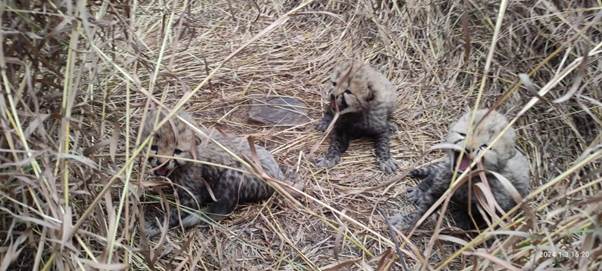In yet another indicator of the success of the Project Cheetah at the Kuno National Park in Madhya Pradesh, Namibian Cheetah Aasha has delivered three cubs. Welcoming the cubs, Union Minister for Environment, Forest and Climate Change and Labour and Employment Shri Bhupender Yadav said he was thrilled to share that Kuno National Park has welcomed three new cubs born to Namibian Cheetah Aasha.
Aasha is the second Namibian Cheetah to deliver cubs and landed at the Kuno National Park along with seven other cheetahs, ironically, in a crate named ‘Aasha – The Hope’. Coincidently incumbent of that crate had no name and thus came to be named ‘Aasha’.
Aasha is the second Namibian Cheetah to deliver cubs and landed at the Kuno National Park along with seven other cheetahs, ironically, in a crate named ‘Aasha – The Hope’. Coincidently incumbent of that crate had no name and thus came to be named ‘Aasha’.
According to officials at the KNP, the five-year-old wild cat, had carried herself in such a manner in the last one year that gives lots of hope for the successful introduction and establishment of cheetahs in India. From the very first day, she looks calm, un-stressed and has behaved like a wild cheetah. She was wary of human presence but was not too perturbed by it. After spending 70 days in Quarantine Boma (QB), on 27th November 2022, she was released in the wild. Aasha enjoyed her freedom from QB and never faced any difficulty in finding prey or negotiating geography and vegetation. She was not very difficult to monitor twice a day as she did not vanish seeing approaching humans
Aasha has Pawan (Oban), a male Namibian cheetah, as a neighbour. Both had fairly good interactions along the common fence of their respective enclaves. Looking at this, both were given the opportunity for more interactions by opening the gate between them. Aasha was later released in the wild of KNP on March 11, 2023. Aasha’s story of exploration is a telling story of the successful adoption of landscape geography and a hot summer. Earlier in March, one of the other female cheetahs relocated from Namibia to India had four cubs on.
Earlier in March, one of the other female cheetahs relocated from Namibia to India had four cubs on.
The Government of India had decided to introduce the Cheetah, the only large carnivore species that went extinct in Independent India. The Cheetahs for release into the selected sites in India are sourced from the ancestral South African cheetah and Namibian populations depending on the suitability and continued availability of animals. This international endeavor will not only strengthen the efforts for global conservation of the Cheetah but also the re-establishment of his species in its historical range.
Bringing the Cheetah back to India has vital and far-reaching conservation consequences with the following ecological objectives which include:
(i) Re-establish the functional role of the Cheetah in representative ecosystems within its historical range. Here the cheetah will serve as a flagship to save not only its prey-base, but also other endangered species of the grassland and semi-arid ecosystems. Resources invested in these highly exploited and neglected systems will ensure better management and restore their ecosystem services for the country.
(ii) Contribute to the global effort towards conservation of the Cheetah as a species.
(iii) Additionally, Cheetah introduction is likely to improve and enhance the livelihood options and economies of the local communities.


